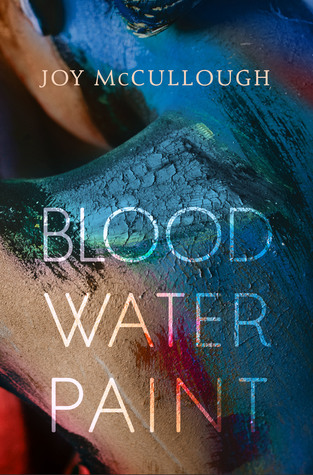Blood Water Paint by Joy McCullough
Historical Fiction in Verse, 304 pages
Published March 6, 2018 by Dutton
My rating: ★★★★
This book is both fascinating and timely, and I appreciate it in so many ways.
It's a fictionalized first-person account of the real seventeenth-century Italian painter Artemisia Gentileschi, who was known for being one of the rare women to take her rapist to trial.

In the book, she is working on one of her most famous paintings, Susanna and the Elders, and the Biblical story of Susanna's rape and trial in the Book of Daniel is incorporated into Artemisia's story. In fact, there is a magical realist element to this book where the subjects of Artemisia's paintings speak to her and interact with her in her darker moments. There are also chapters in prose, told from the perspective of Artemisia's deceased mother, where she recounts the Biblical stories and warns her daughter of dangers women experience while highlighting women's strength.
Both the verse and prose are sharply written and bring these topics to light in a fierce and beautiful way. I will say, however, that frequently switching between the two interrupted my reading flow, since they are two such distinct voices and styles. It also took me a while to figure out who Susanna seeing as I have about zero familiarity with the Bible or art history, which was frustrating at first.
(This is why I'm including pictures and all the stuff I had to Wikipedia in order to follow along)
The current social climate, where we are starting to have a more serious and open conversation about injustices toward women like sexual assault and rape, adds urgency and relevence to this story. I was curious but reluctant about what this would add to the conversation, since I don't think anyone doubts that women used to have it hard in the seventeenth century. After reading this book (and also, notably, Mackenzi Lee's recent nonfiction collection Bygone Badass Broads) I am learning to appreciate the importance of remembering women in history who, yes, may have been victims, but who had the courage to go against the grain of society and fight for justice and a better life. Artemisia is punished and shamed for trying her rapist in court -- and it may be different for women today, but there are still undeniable consequences to pressing charges against a rapist today that discourage women from doing so.
You begin to realize not as much has changed as you think, but you also draw strength from the women in history who have persisted, just as Artemisia draws from her mother's tales of Susanna and Judith.

Artemesia's painting Judith Slaying Holofernes is also prominently featured in the story and is particularly imbued with the pain of her rape. She actually painted herself as Judith in this picture, and her rapist as Holofernes. The painting is recognized for refusing to shy away from Judith's effort and Holofernes' blood, as opposed to other iterations where there is less blood and pain on Judith's part. And the book reflects upon the differences in how men and women (specifically Artemisia) depicted women in art. It reminds me of how women today are exposing the ugly truths of womanhood with the #MeToo movement, refusing to let men paint their truths.
For all that this book is beautifully written -- for all its sharp verse and soft, whispering prose, for all of the bared strength of women (and weaknesses of other women as well), all the evocations of women's hertiage, from Biblical times to the seventeenth century to your own mother -- For all that this book speaks women's empowerment... I didn't always like reading it. If the verse didn't read so quickly I might have put it down. Although each line seems so carefully written, the whole of it was often confusing. Artemesia is a character I admire, but not one I feel like I can embody or connect with (which I generally consider to be an important element of YA). I don't think I would have had patience for this as a teen, I wouldn't have seen myself in it. There is an emotional distance, and a barrier in some of the unexplained historical elements that make this feel almost totally unlike YA.
Part of me wants everyone to read this, and the academic in me is particularly enamored of how this book makes the lives of women, historical and literary, throughout time feel applicable to our time now. And yet as bookseller, I haven't figured out exactly who I would recommend it to. Which kind of breaks my heart. Because if nothing else, this is the kind of book I will never forget.

No comments
Post a Comment